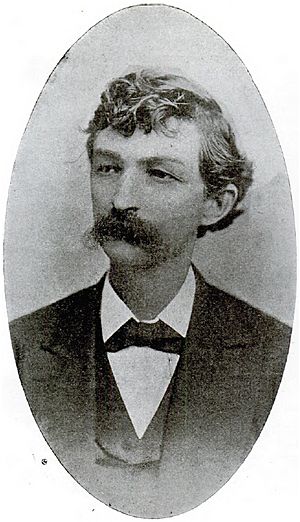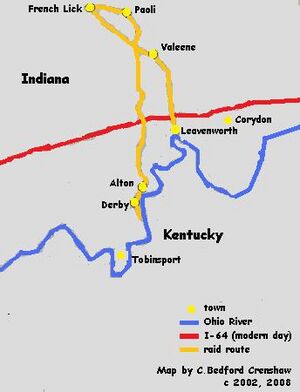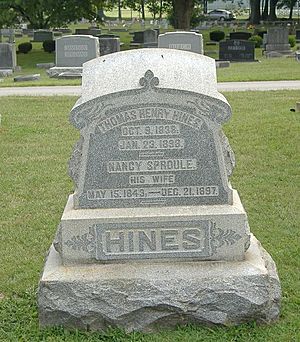Thomas Hines facts for kids
Quick facts for kids
Thomas Hines
|
|
|---|---|

Thomas Hines
|
|
| Born | October 8, 1838 Butler County, Kentucky |
| Died | January 23, 1898 (aged 59) Frankfort, Kentucky |
| Allegiance | |
| Service/ |
|
| Years of service | 1861–65 (CSA) |
| Rank | |
| Unit | |
| Commands held | "Buckner's Guides" |
| Battles/wars | American Civil War
|
Thomas Henry Hines (born October 8, 1838 – died January 23, 1898) was a Confederate cavalryman. He became well-known for his secret spying activities during the last two years of the American Civil War. Thomas Hines was born in Butler County, Kentucky. Before the war, he taught grammar, mostly at the Masonic University in La Grange, Kentucky.
During the first year of the war, he was a field officer. He led several secret missions. He was a key helper to John Hunt Morgan. Hines even did a special mission (Hines' Raid) before Morgan's Raid into Indiana and Ohio. After being caught with Morgan, he planned their escape from the Ohio Penitentiary. Later, he worked as a spy. He tried to cause trouble against the United States government in some Northern cities.
Thomas Hines often had to make amazing escapes during the war. Once, he hid inside a mattress. Another time, people thought he was John Wilkes Booth, who had just killed President Lincoln. This was very dangerous. It made Hines flee Detroit in April 1865. He even had to make a ferry captain take him across a river using a gun. Agents from the Union side wanted to catch Hines more than anyone. But except for his time in the Ohio Penitentiary in 1863, they never did.
After the war ended, it was safe for Hines to go back to Kentucky. He settled in Bowling Green with his family. He became a lawyer. This led him to serve on the Kentucky Court of Appeals, where he became the chief judge. Later, he practiced law in Frankfort, Kentucky, until he died in 1898. He kept many secrets about Confederate spying hidden from the public.
Contents
Early Life and Joining the War
Thomas Hines was born in Butler County, Kentucky, on October 8, 1838. His parents were Judge Warren W. and Sarah Carson Hines. He grew up in Warren County, Kentucky. He learned a lot on his own, but also went to regular schools. He was about 5 feet 9 inches (1.75 m) tall and weighed only 140 pounds (64 kg).
People said Hines looked gentle because he was slender. A friend even said his voice sounded like a "refined woman." He liked women, music, and horses. In 1859, he became a professor at the Masonic University. This school in La Grange was for orphans of Kentucky Freemasons. He was the head of its grammar school. But when the war started, he joined the Confederate Army in September 1861.
Thomas Hines in the Civil War
Early Missions and Becoming a Spy
Thomas Hines joined the Confederate army. At least eleven of his cousins also joined. Hines first led a group called "Buckner's Guides." These guides were part of Albert Sidney Johnston's army. His fellow guides saw that he was "cool and a good leader." In November 1861, he became a lieutenant. On December 31, 1861, he led a successful mission. They attacked a Union outpost at Borah's Ferry, Kentucky.
The Guides group ended in January 1862. This happened after the Confederate government of Kentucky left Bowling Green. Hines only wanted to fight in Kentucky. He traveled to Richmond, Virginia. Because of this, he missed the Battle of Shiloh. In April, he decided to join Brig. Gen. John Hunt Morgan. He joined the army again as a private in the 9th Kentucky Cavalry in May 1862.
Morgan saw how talented Hines was. He made Hines a captain on June 10, 1862. After that, Hines spent most of his time on secret missions in Kentucky. He often wore regular clothes. He usually worked alone so people would not notice him. He did not want to be executed as a spy.
On many trips into Kentucky, Hines visited people he loved. He often saw Nancy Sproule, his childhood sweetheart and future wife. She lived in Brown's Lock, near Bowling Green. Other times, he visited his parents in Lexington, Kentucky. In both places, Union spies tried to catch Hines. But he always got away. This happened even after his father was captured and his mother was sick.
Daring Invasions and a Great Escape
In June 1863, Hines led a secret mission into Indiana. He had 25 Confederates with him. They pretended to be a Union group looking for soldiers who had run away. Their goal was to see if local people who did not support the Union would help John Hunt Morgan's planned invasion in July 1863. They traveled through Kentucky for eight days to get supplies. Then, they crossed the Ohio River into Indiana. This was near Derby, on June 18, 1863.
Hines met with a local leader who did not support the Union, Dr. William A. Bowles. This was in French Lick. Hines learned that there would be no official help for Morgan's Raid. On his way back to Kentucky, Hines and his men were found in Valeene, Indiana. This led to a small fight near Leavenworth, Indiana, on Little Blue Island. Hines had to leave his men. He swam across the Ohio River while being shot at.
After wandering in Kentucky for a week, Hines met General Morgan again. This was at Brandenburg, Kentucky. Colonel Basil W. Duke wrote in his memories that Hines looked "listless and harmless." Colonel Duke was Morgan's second-in-command. But he was not usually told about all of Hines's spy work. Some people thought Hines and Duke did not like each other, but this was not true.
Hines helped capture two riverboats, the Alice Dean and the John T. McCombs. These boats were used to carry Morgan's over 2000 men across the Ohio River. Hines's reports made Morgan treat anyone who pretended to be a Confederate supporter in Indiana roughly. Morgan had been counting on help from supporters in Indiana for his raid to work. Hines stayed with Morgan until the raid ended. He was with John Hunt Morgan when they were captured. First, they were held at Johnson's Island. Then, they were moved to the Ohio Penitentiary near Columbus, Ohio. Even though war rules said prisoners of war should go to military prisons, they were put with regular criminals.
The Great Prison Escape
Hines found a way to escape from the Ohio Penitentiary. He had been reading the book Les Misérables. People said he was inspired by the character Jean Valjean and his escapes through tunnels under Paris, France. Hines noticed that the lower prison cells were very dry. They had no mold, even though no sunlight reached them. This made him think that they could tunnel downwards to escape.
Hines found an air chamber under their cells, just as he had guessed. He started digging a tunnel. The tunnel was only eighteen inches wide. This was just big enough for him to get into the four-foot by four-foot air chamber. This chamber was surrounded by thick stone walls. Hines and the six other men with him, including John Hunt Morgan, worked on the tunnel. They used a thin layer of dirt to hide their digging from the prison guards.
They dug for six weeks. The tunnel's exit came out between the inner and the 25-foot (7.6 m) outer prison walls, near a coal pile. On the day of the escape, November 26, 1863, Morgan switched cells with his brother, Colonel Richard Morgan. They chose this day because a new Union military commander was coming to Columbus. Morgan knew the prison cells would be checked then.
After the daily midnight check, Hines, John Hunt Morgan, and five captains under Morgan's command used the tunnel to escape. The prison guards were hiding from a big storm outside. This helped the Confederate officers. They climbed the 25-foot-tall (7.6 m) wall easily, using metal hooks.
Hines even left a note for the warden. It said: "Warden N. Merion, the Faithful, the Vigilant" and then: "Castle Merion, Cell No. 20. November 27, 1863. Start, November 4, 1863. Finish, November 20, 1863. Work hours per day, three. Tools, two small knives. La patience est amere, mais son fruit est doux. By order of my six honorable confederates." The prisoners left behind were searched and moved to different cells. Two of the officers who escaped with Hines and Morgan were caught four days later in Louisville, Kentucky. But the other three made it safely to Canada and the South.
Hines led John Hunt Morgan back to Confederate lines. First, they went to the train station in downtown Columbus. They bought tickets to Cincinnati, Ohio. The two jumped off the train before it reached the Cincinnati station. They kept avoiding capture in Cincinnati. They stayed one night at the Ben Johnson House in Bardstown, Kentucky. In Tennessee, Hines drew the Union troops' attention away from John Hunt Morgan. Hines was caught again and faced a serious punishment. But he escaped that night by telling stories to the soldier guarding him and then overpowering him. A few days later, he again escaped Union soldiers who wanted to punish him.
The Northwest Conspiracy
Hines went to the Confederate capital of Richmond, Virginia, after his escape in January 1864. He convinced Confederate President Jefferson Davis of a plan. The plan was to cause widespread panic in the Northern states. This would be done by freeing prisoners and starting fires in large Northern cities. Davis was impressed by Hines's plan and agreed to support him.
Davis told Hines to tell his plan to Secretary of State Judah P. Benjamin and Secretary of War James Seddon. Both men agreed to the plan. They encouraged Hines to go ahead. The only worry for Davis, Benjamin, and Seddon was what people would think. They wondered what Great Britain and France would think of Hines's actions.
Hines thought it would be easier to enter the North from Canada. He traveled there during the winter. Hines led the Northwest Conspiracy from Canada in the fall of 1864. Colonel Benjamin Anderson was part of the plan, along with other Confederate soldiers. They hoped Hines and his men could free the Confederate prisoners held at Camp Douglas in Chicago, Illinois.
Hines led sixty men from Toronto, Ontario, on August 25, 1864. They arrived during the Democratic Party National Convention in Chicago that year. People who did not support the Union had told Hines to wait until then. They said 50,000 of them would be there. However, these people were hesitant to help Hines and his group. Also, Federal authorities seemed to know about the plan. Hines and his men had to flee Chicago on August 30, 1864. Many of the men thought Anderson might have been a double agent. This made Anderson leave the group. A second try to free the Camp Douglas Confederate prisoners happened during the United States Presidential Election of 1864. But that plan also failed.
In the same year, Hines tried to free Confederate prisoners of war. He recruited former members of Morgan's Raiders who had escaped to Canada. This included John Hunt Morgan's telegraph operator George "Lightning" Ellsworth, who was from Canada. On his last day in Chicago, Hines had to avoid being found by Union soldiers. They were checking the home he was hiding in. He crawled into a mattress where the homeowner's wife was sick. The Union soldiers checked the house. They even looked to see if Hines was the one on the bed. But they did not find Hines in the mattress. The soldiers put a guard by the door of the house. The next day, it rained. Visitors were encouraged to see the sick woman. The soldiers never looked at the faces under the umbrellas. Because of this, Hines snuck out of the house and left Chicago.
Late War Adventures
In October 1864, Hines went to Cincinnati again. He had secretly crossed through Indiana, where Union troops were still looking for him. This time, friends helped him. He hid in an old closet covered by mortar and red bricks. He avoided being found by Union troops who searched the house. Hines learned there that his beloved Nancy Sproule was in an Ohio convent. He decided to help her leave.
On November 10, 1864, they were married at St. Mary's Catholic Church in Covington, Kentucky. This was against her father's wishes, who wanted them to wait until the war was over. They spent a week's honeymoon in Kentucky. After that, Hines went back to his secret activities in Canada.
Two days after Lincoln's death, on April 16, 1865, Hines was in Detroit, Michigan. People thought he was John Wilkes Booth, who was being hunted by many people. After getting into a fight, Hines jumped over several fences. He made his way to Detroit's wharf. He waited for a ferryboat to drop off its passengers. Then he used a gun to make the captain take him across the Detroit River to Canada. When they arrived, Hines said sorry to the captain and gave him five dollars. This event led to a false rumor that Booth had escaped into Canada.
Life After the War
After escaping from Detroit, Hines went to Toronto. Many other former Confederates lived there. He did not expect to return to the United States. So, he sent for his wife, Nancy. In Toronto, he studied law with General John C. Breckinridge, who used to be a Vice President of the United States.
When U.S. President Andrew Johnson offered a pardon to most former Confederates, Hines went back to Detroit. He signed a loyalty oath to the United States on July 20, 1865. However, he knew that Union officials in Kentucky would not include him in the pardon. So, he stayed in Canada until May 1866.
After sending his wife to Kentucky, where their first child was born, Hines started living in Memphis, Tennessee. He passed the bar exam (to become a lawyer) with high honors on June 12, 1866. While in Memphis, he also worked as an editor for the Daily Appeal newspaper. Hines moved to Bowling Green, Kentucky, in 1867. Many of his family lived there, and he practiced law. Basil W. Duke made Hines a colonel in the Soldiers of the Red Cross. Hines later became the County Judge for Warren County, Kentucky.
Hines was chosen to be a judge on the Kentucky Court of Appeals in 1878. He served there until 1886. From 1884 to 1886, he was the Chief Justice. People said he was "exceptionally fair as a judge." Hines saw a sad event on March 26, 1879. Another judge, John Milton Elliott, was hurt while leaving the Kentucky State House. Colonel Thomas Buford, a judge from Henry County, Kentucky, was involved. Buford was angry because Elliott did not rule in favor of his late sister in a property dispute. Buford shot Elliott after Hines had turned away. Hines checked on Elliott as Buford gave himself up to a deputy sheriff.
After his time on the Kentucky Court of Appeals, Hines went back to practicing law in Frankfort, Kentucky. In 1886, Hines started writing four articles about the Northwest Conspiracy. These were for Basil W. Duke's Southern Bivouac magazine. The magazine honored the memory of the Lost Cause of the Confederacy. But it was less harsh than other Southern magazines. It gained more readers in the North. The first article was printed in December 1886.
However, Hines talked with former Confederate President Jefferson Davis at Davis's home in Mississippi. Hines decided not to name anyone from the Northern side who helped in the conspiracy. After writing the first article, Hines was criticized. Newspaper reviewers (especially from the Louisville Times) and Southern readers said he was not open enough about all the people involved. This made Hines not want to publish any more stories about the Northwest Conspiracy.
Thomas Hines died in 1898 in Frankfort. He was buried in Fairview Cemetery in Bowling Green, Kentucky. His grave is in the Hines family plots. The grave of Duncan Hines, who was a distant cousin, is also in these plots.
Common Mistakes About Hines
Sometimes, historical markers about Hines's actions have wrong information. A marker in Indiana, put up in 1963, says Hines invaded Indiana in 1862. But he actually did it in 1863. Also, a marker at the Confederate Monument of Bowling Green in Fairview Cemetery says Hines died before a ceremony in 1876. But he really died in 1898 and is buried nearby.



